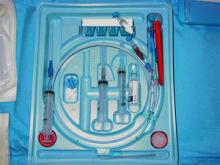The number of central line–associated bloodstream infections occurring in intensive care units across the United States dropped by about 25,000 or 58% from 2001 to 2009, according to new data from the Centers for Disease Control and Prevention.
This decrease in infections means that about 3,000 to 6,000 lives were likely saved and about $414 million saved in ICUs in 2009 alone. The data was published in the March 1 issue of the Morbidity and Mortality Weekly report (MMWR 2011;60:1-6). Researchers at the CDC estimate that during 2001-2009, the prevention of central line–associated bloodstream infections in ICUs resulted in total savings of about $1.8 billion and as many as 27,000 lives saved.
Researchers found the greatest decrease in central line–associated bloodstream infections in the ICU were for Staphylococcus aureus infections, which dropped 73% between 2009 and 2001. Gram-negative pathogens such as Escherichia coli, Acinetobacter baumannii, Pseudomonas aeruginosa, and Klebsiella spp., were reduced by about 37% during the 9-year time period. Candida spp. infections were reduced by 46% and Enterococcus spp. infections dropped by 55% as well.
The findings demonstrate a shift within the medical community, which had for many years considered central line infections a regular and acceptable part of practice, said Dr. Thomas R. Frieden, CDC director, during a press conference on March 1. "We now have a new normal in health care where central line infections are unacceptable," he said.
To estimate the total number of central line–associated bloodstream infections in the United States, researchers at the CDC multiplied central line use and infection rates by estimates of the total number of patient-days in ICUs, inpatient wards, and outpatient hemodialysis centers.
The data shows that in 2009, there were about 18,000 central line–associated bloodstream infections in ICUs, compared with 23,000 in inpatient wards. Also, data from 2008 shows that outpatient hemodialysis facilities had about 37,000 central line–associated bloodstream infections.
While infections have dropped dramatically within ICUs, Dr. Frieden said health care providers and researchers must now turn their attention to hemodialysis centers, where about 1 out of every 10 patients on dialysis gets a life-threatening infection. Reducing infections in hemodialysis centers is especially important, he said, because the number of patients on dialysis is expected to double over the next decade.
And Dr. Frieden had a message for health care providers in all settings: Use central lines only when they are essential and, if they are used, get them out as quickly as possible. For example, in hemodialysis, arteriovenous fistulas, or arteriovenous grafts can be used instead of central lines in many cases, according to the study.


